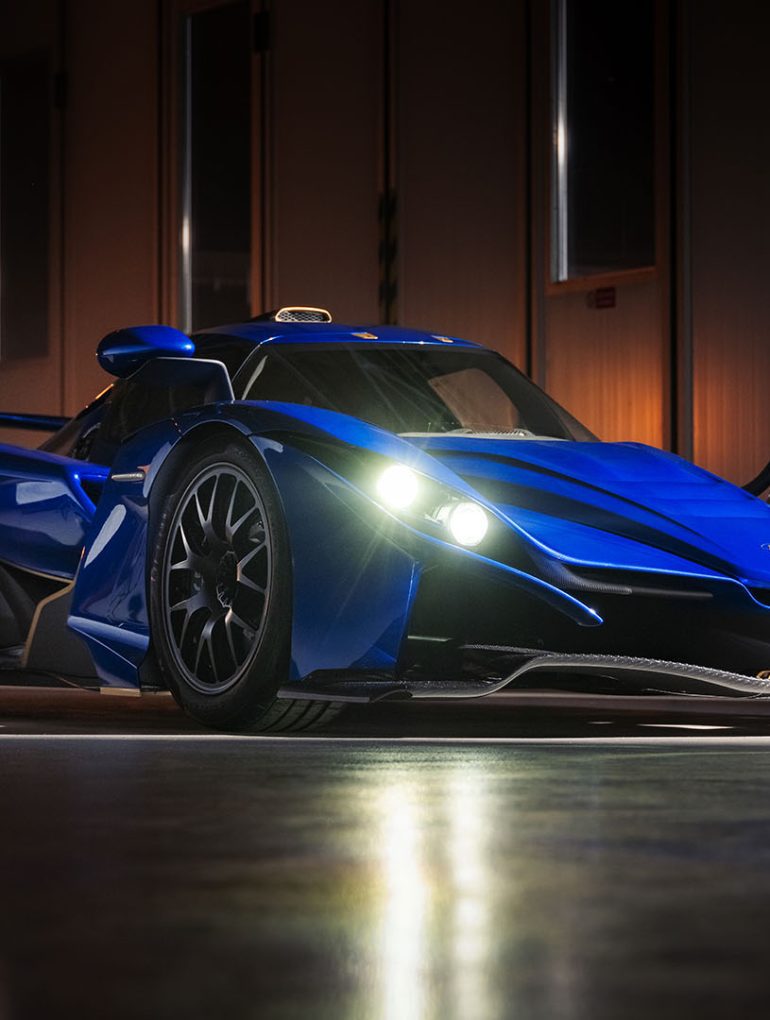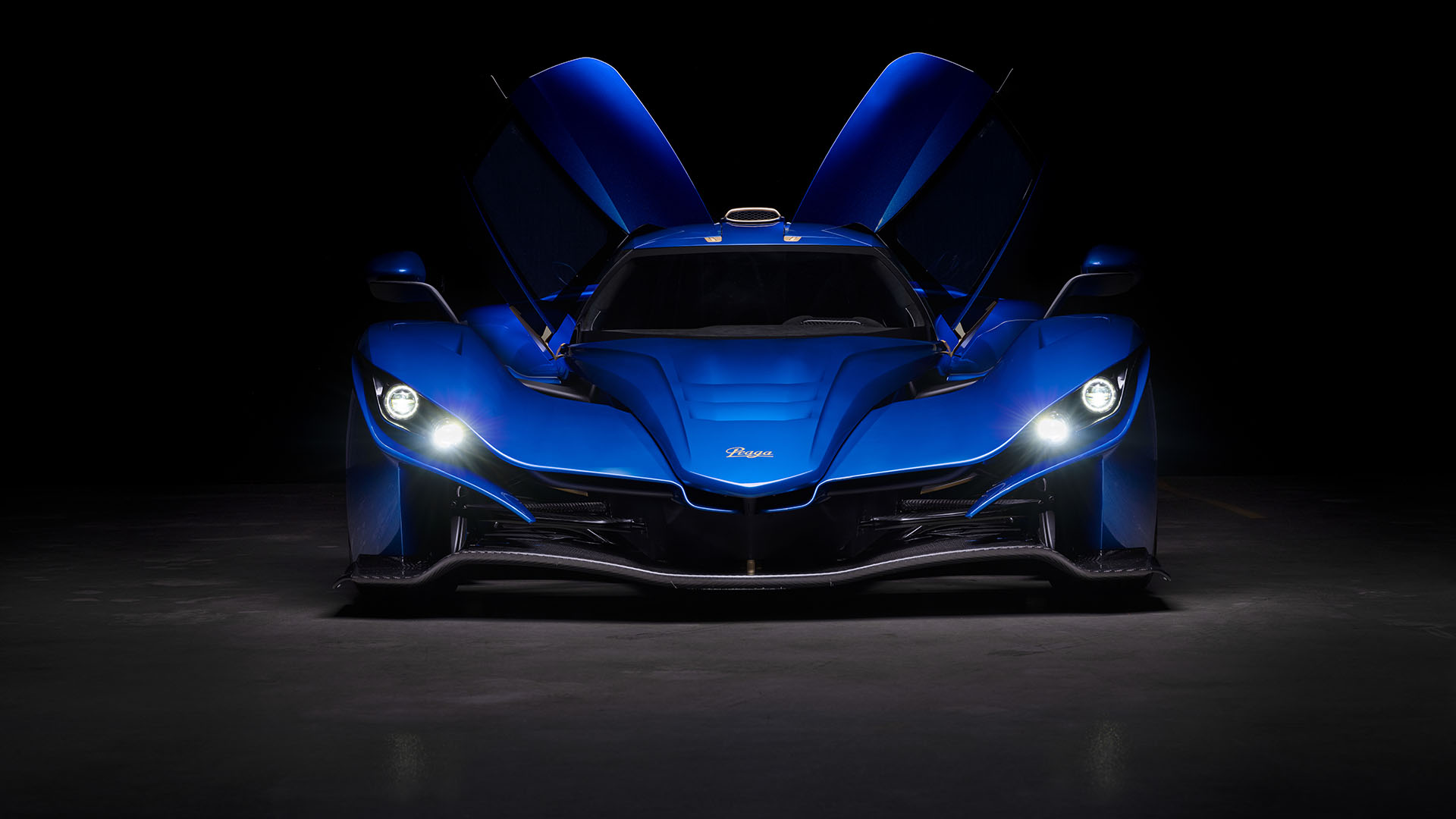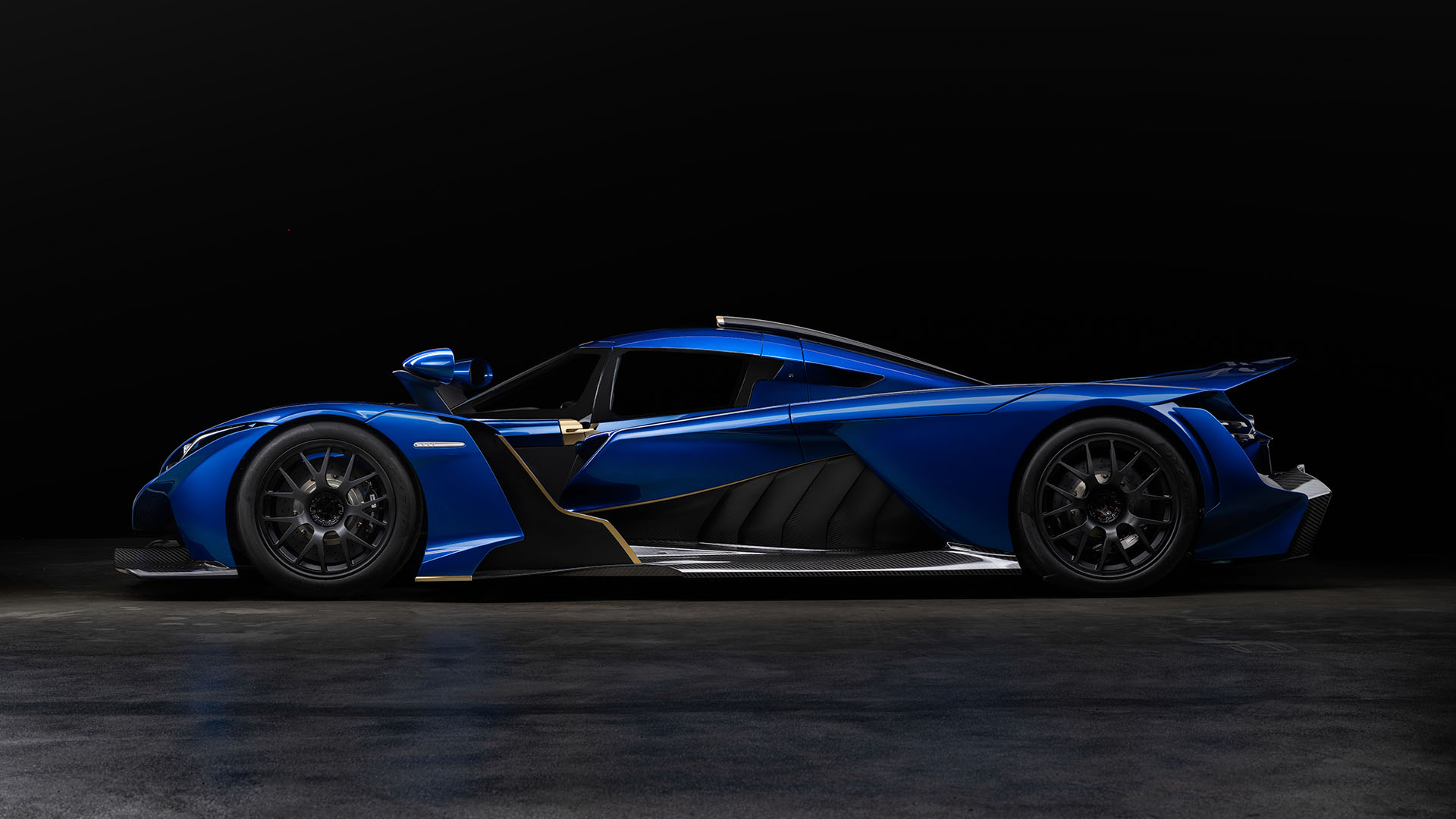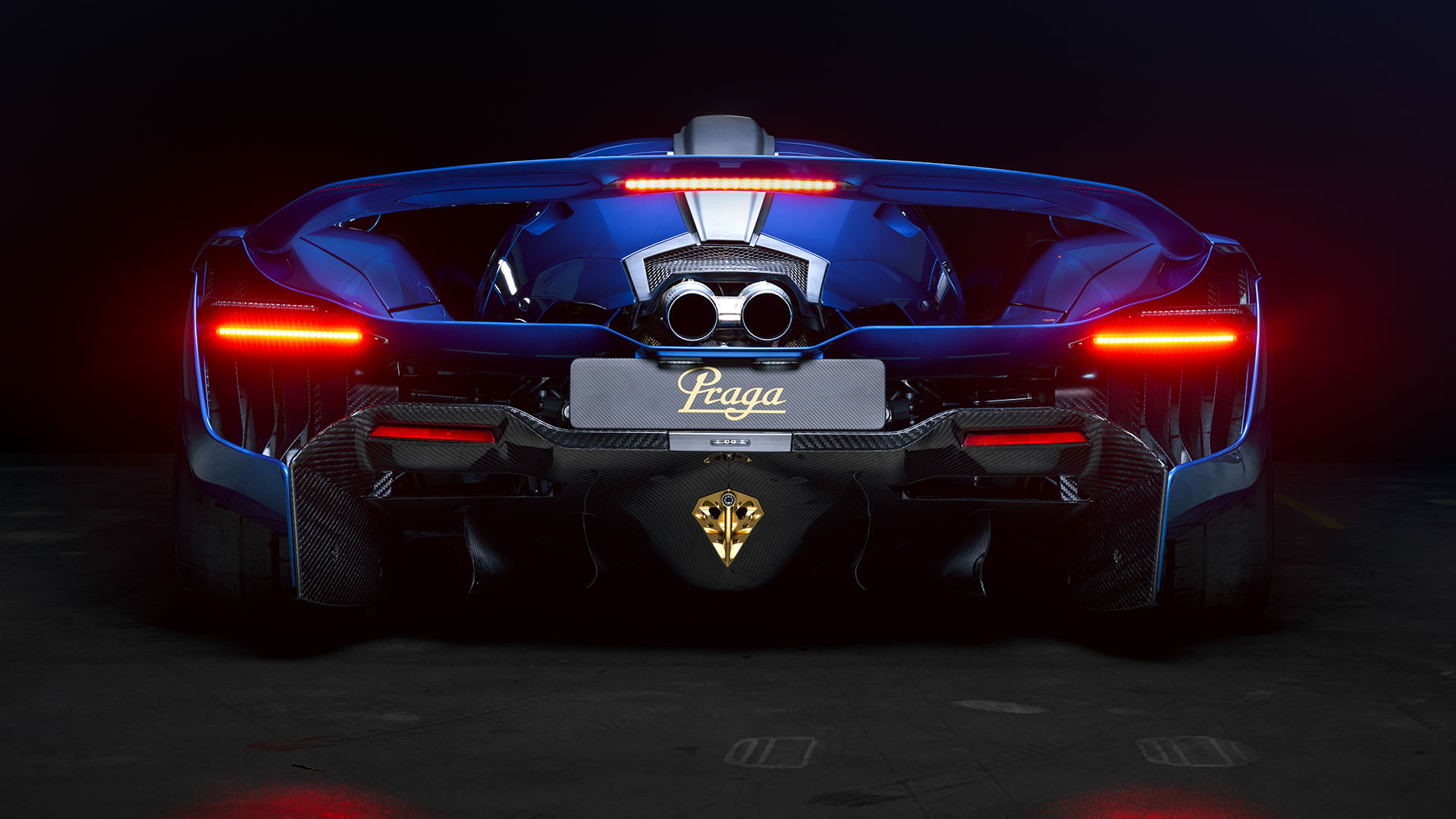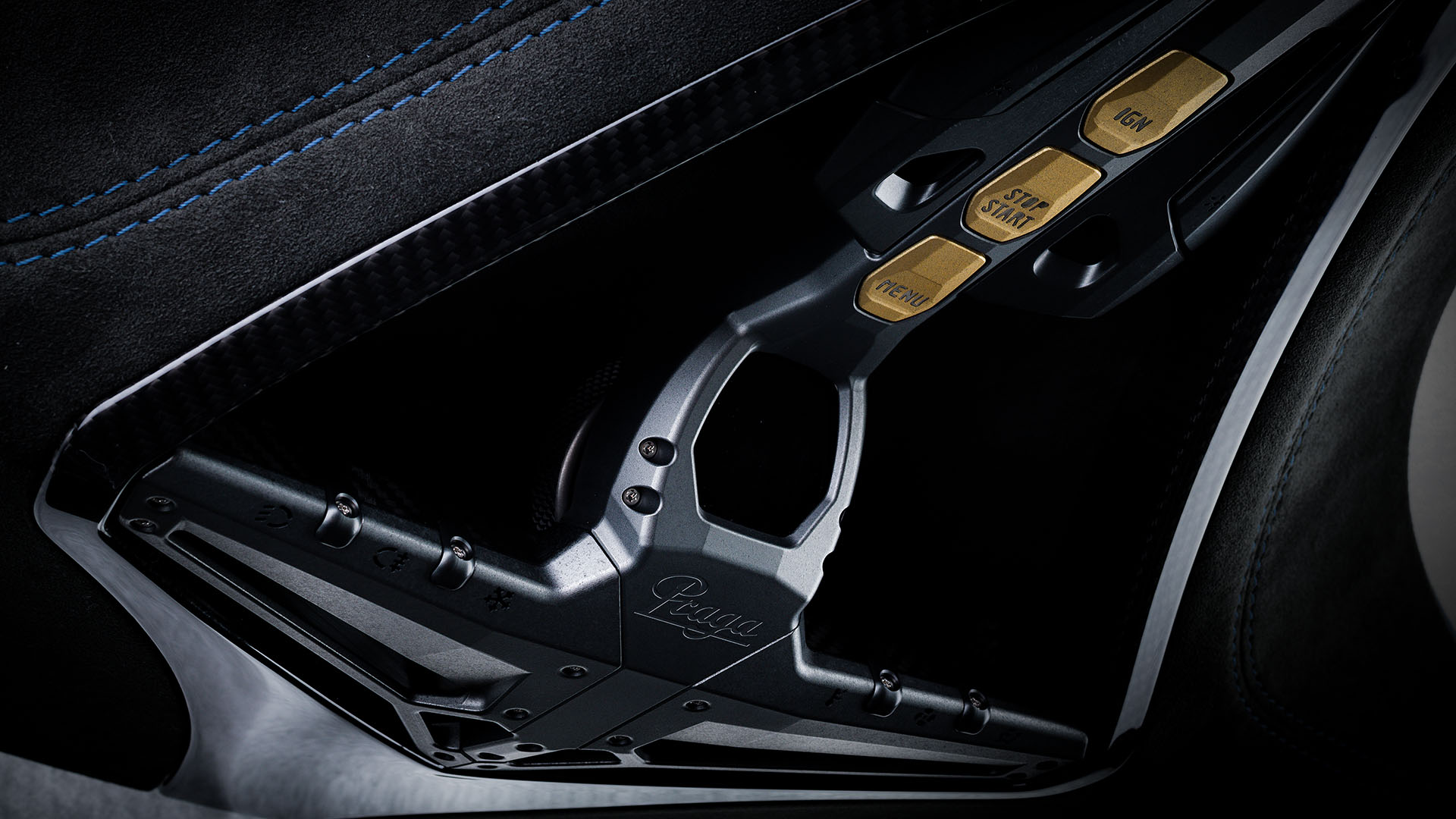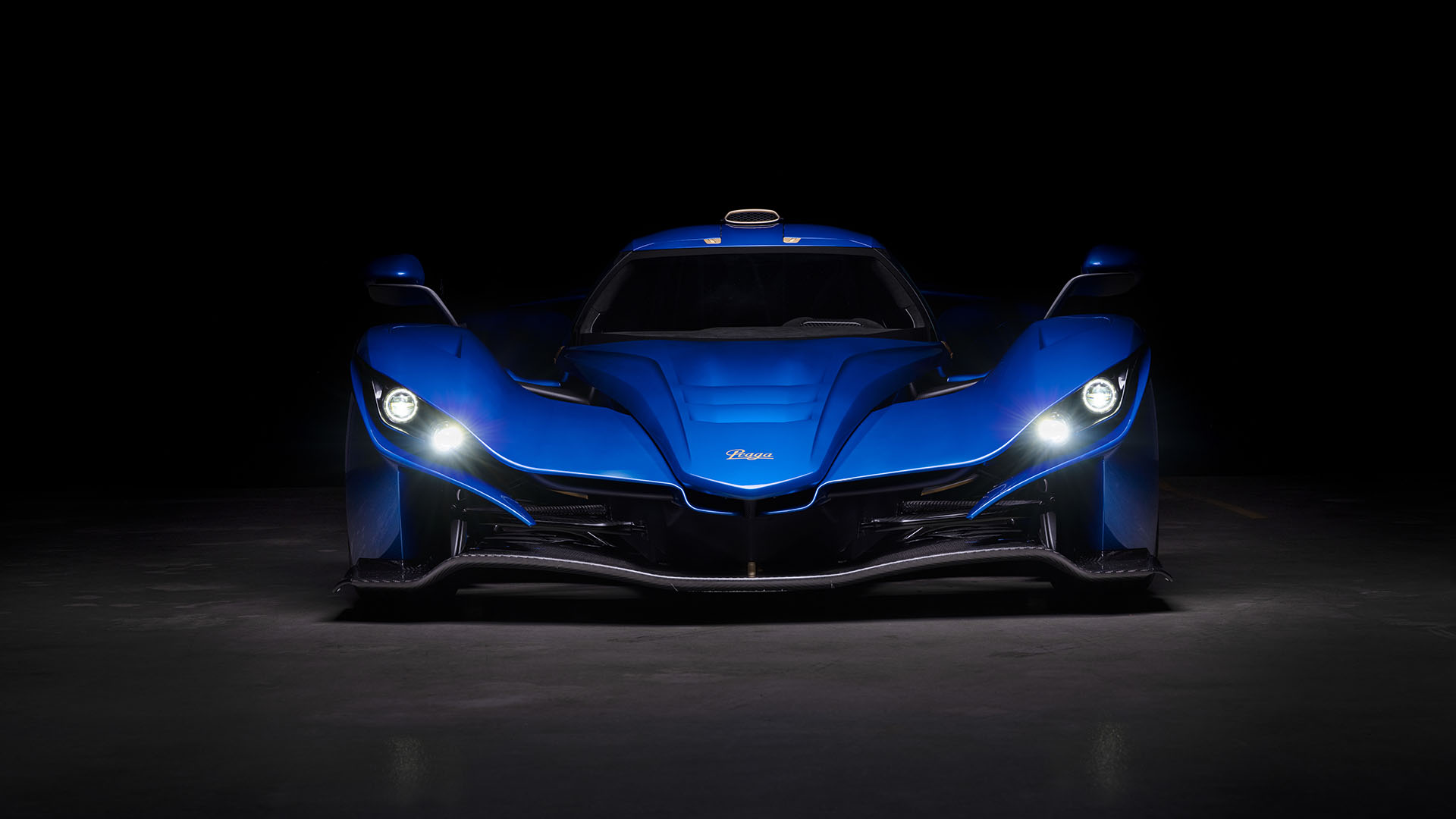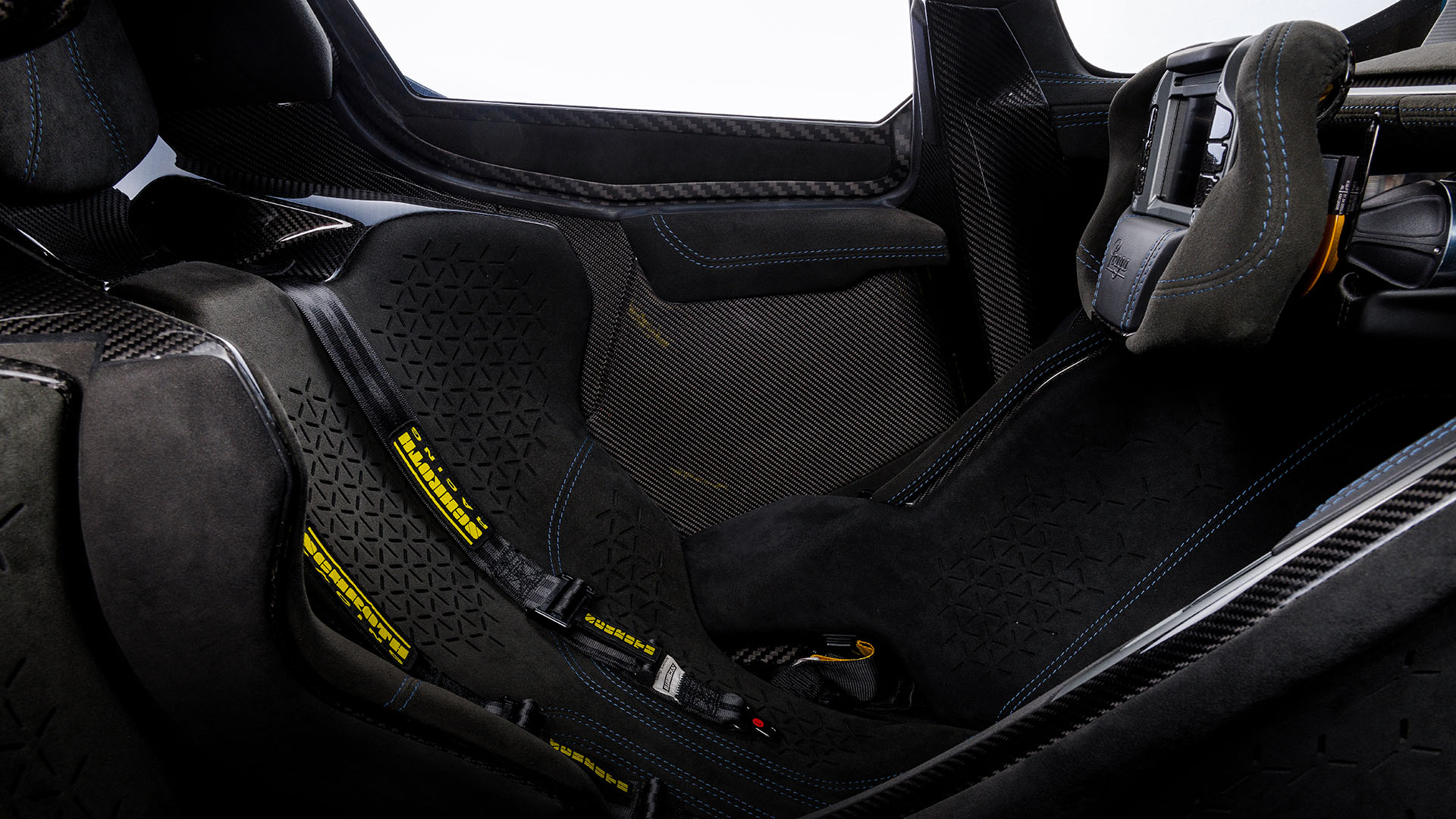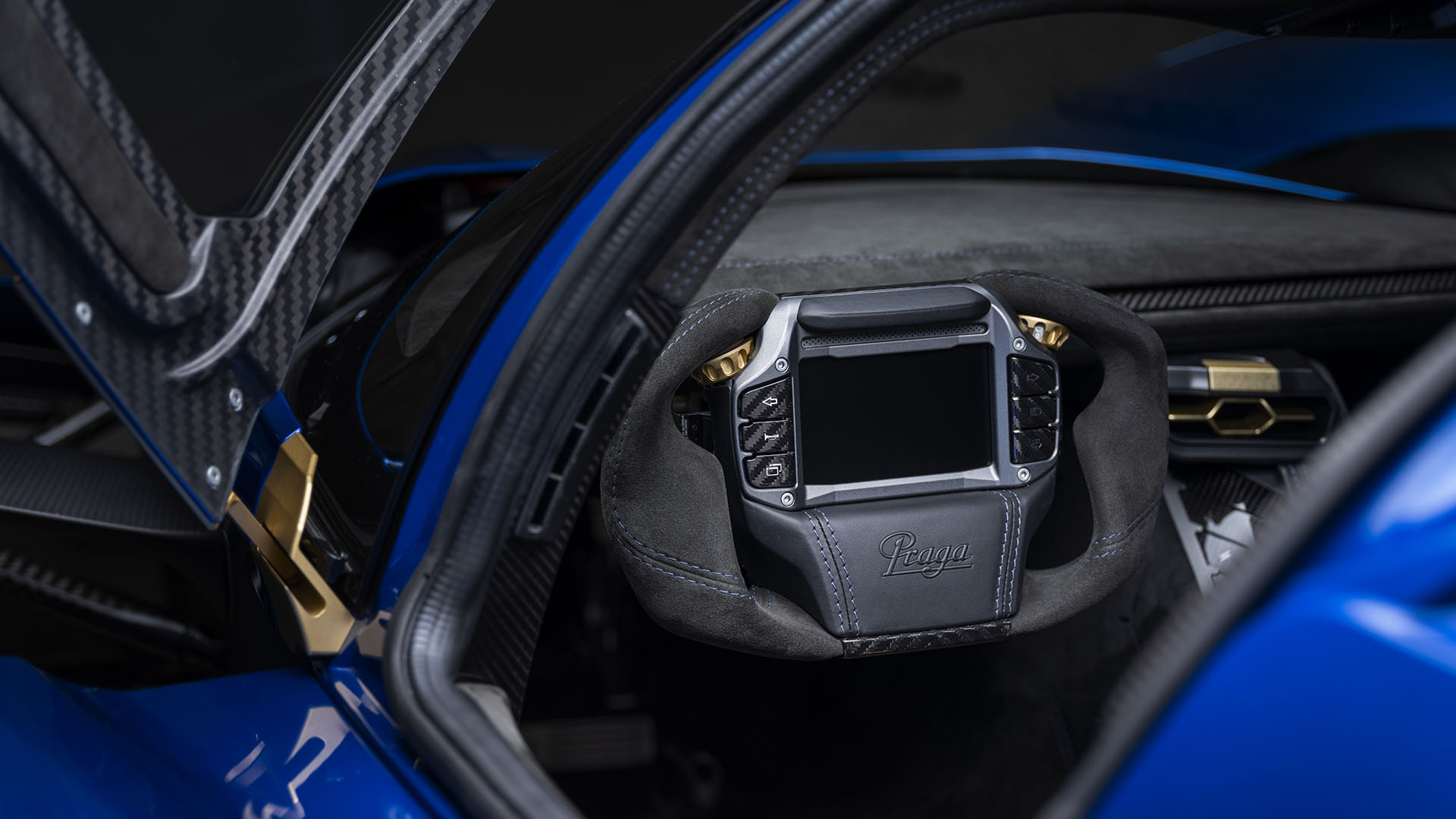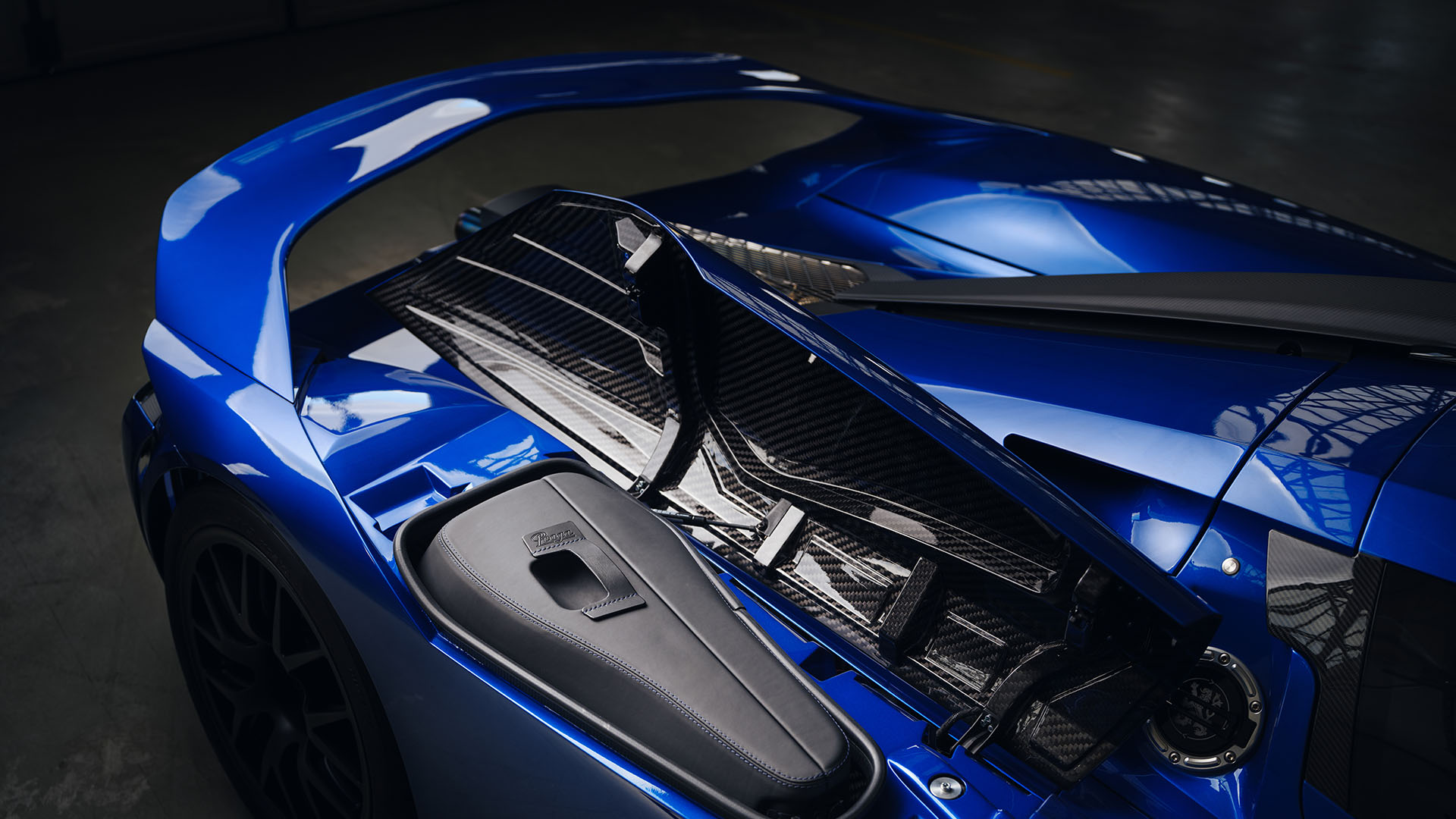The historic automotive company Praga, currently a global player in various on- and off-track racing disciplines around the world, revealed its all-new road-legal hypercar in pre-production prototype form: a high-performance, low-volume, beautifully-appointed car designed around three core principles – lightweight, carbon, gasoline.
The new Praga Bohema is a sub-2,204 pounds, mid-engined two-seater that, in the right hands, is capable of extremely high performance on track targeting GT3 race car lap times on its semi-slick Pirellis. Yet it is also comfortable and practical for head-turning road trips. With its carbon fiber monocoque and race-oriented fully adjustable suspension, it is extremely light, targeting just 2,164 lbs (wet without fuel), while its powerful Nissan GT-R-derived six-cylinder twin-turbo engine ensures reliability, ease of servicing, and the potential for further performance tuning. While the Bohema’s race-derived semi-automatic transmission will support a unique on-road experience with track-focused performance.
The goal? That the Bohema is a uniquely styled, rare, and exclusive car that you really can drive to the track, pull on a crash helmet (taken from the bespoke luggage fitted in each of the car’s innovative 13.2 US gallon side pods), put in lap after lap at high speed on its Pirelli Trofeo R tires, and then drive home again. The inspiration? Longstanding Praga friend and ambassador, and former F1 and current IndyCar driver, Romain Grosjean challenged Praga to deliver a genuine uncompromised two-person road/track performance car, promising a truly unique driver experience. He was subsequently involved in the Bohema project and highlighted the car’s seamless transition from road to track while delivering extensive sessions on the challenging 3.7-mile Slovakia Ring circuit in recent testing.
“I was astonished by the Bohema’s amazing performance on track, its accessibility on road, and the ease of transition between the two,” said Romain. “Praga truly delivered on my challenge! On the road, you get a smooth ride, the car eliminates the bumps, you can chat with the passenger, and everything is calm and OK. Then simply switch focus and you are on the track. The same clothes, the same car, but the feeling changes and you are pushing the limit and collecting amazing lap times again and again, discovering unbelievable possibilities in the Bohema. And we still have a few months to fine-tune the on-road compliance and on-track lap times!”
The result? The Bohema is an all-new design, developed by Praga’s small, but talented team of engineers and designers, and perfected in an F1 team’s wind tunnel. It uses a race-derived carbon fiber monocoque, with extensive aero providing over 1,984 lbs of downforce at 155 mph. Top speed is just over 186 mph: the fastest speed achievable on virtually any racetrack. Crucially, the car’s aerodynamically-inspired engineering did not eliminate elegant and intriguing designed bodywork to ensure the car looks fast, and looks good. High quality machined Praga Gold painted duraluminum details include door hinges and a tow hook featuring an integrated rear-facing camera that stand out on the Praga blue show car and reflect Praga’s attention to detail. The Bohema is that rarest of cars with the ‘wow’ factor in both looks and performance.
Unlike many racetrack-derived performance cars, the Bohema’s ingenious interior ergonomics delivers a narrow, aerodynamically honed cockpit yet seats two, 6.5-feet-tall adults with fully adjustable driver’s seat, steering wheel and pedals, generous luggage space, aircon and useful rear visibility. All at less than 2,204 lbs. Praga’s obsession with its sub-2,204 pounds target weight is highlighted by the Bohema’s cockpit statistics: structurally designed with 56 individual carbon parts, and trimmed with high-quality Alcantara and leather, the cockpit’s target weight is just 74.9 lbs. The focus on keeping the Bohema under 2,204 lbs is demonstrated by Praga’s remarkable attention to detail in every aspect of the design, with extensive use made of carbon fiber, magnesium alloys and titanium.
Its independent suspension uses pushrod-operated adjustable dampers mounted horizontally for maximum travel while minimizing bodywork height. In such a lightweight car, with just 396.8 lbs of unsprung mass, Praga’s development engineers were still able to keep the suspension supple enough for road use without having to resort to expensive adaptive suspension systems. The central-locked wheels are 18in diameter at the front and 19in at the rear to offer on-road compliance through their large tire walls, but the Bohema will accept 18in wheels all-round, which ensures compatibility with the FIA GT3 spec tire dimension – the race tire with the widest possible range of competition tires globally. The powerful brakes use lightweight but durable 380 mm carbon ceramic discs with six-piston calipers.
The Praga Bohema is entering the final few months of development with road and track programs planned in the UK, Europe, and the Middle East and at the Slovakia Ring home circuit. Production of the $1.31m (+ taxes) hypercar is scheduled to begin in the Czech Republic in the second half of 2023, with just 10 cars initially scheduled for 2023 production. A global client visitor and spec’ing headquarters will also be established in England in 2023, building on Praga’s growing race program in the UK. Approximately 20 cars per year will be hand-built over the following four years ensuring exclusivity for owners, and Praga plans to offer track handover programs with its experienced test-driver lineup for owners to ensure that the full performance and capabilities of the Bohema are understood and accessible.
Praga Bohema in detail
Powertrain
The Praga Bohema’s PL38DETT is based on Nissan’s famed 3.8-liter, twin-turbo V6 engine used in all its GT-R models since 2007. Initially drawing on Nissan’s experience at Le Mans, it is constructed around an aluminum alloy cylinder block, and there are double overhead camshafts per cylinder bank, with a continuously variable valve timing system on the inlet valves. The beauty of this engine is not just its sheer performance potential, but also its renowned reliability and tunability.
Uniquely, Nissan supplies brand new GT-R engines to Praga for the Bohema. Engine development and servicing requirements then sees Praga working with the UK’s renowned Litchfield Engineering; another long-time friend of the Praga brand. Litchfield has more than two decades of tuning experience and is known as the global authority on GT-R engines. Litchfield strips the new engines and converts them to dry sump, which reduces the overall height of the unit by 5.51 in. This allows the engine to sit lower in the Bohema and prevents the risks of oil surge under high-speed cornering loads.
Litchfield also makes a number of modifications for increased reliability and power, including swapping to new twin turbos. In this base-Litchfield specification, Praga is targeting the Bohema production car to deliver up to 700 bhp at 6,800 rpm and 534 lb ft of torque from 3,000 to 6,000 rpm, but Litchfield is known for building 1,000 bhp-plus engines from the GT-R unit. The engine breathes out through exhausts that are titanium right from the turbos to the tailpipes, with much of the silencing provided by the catalytic convertors, giving a sharp crackle to the engine note while remaining within typical circuit noise limits – and ensuring that occupants can still hold a conversation even at well over legal road speed limits.
The Bohema’s engine is mated to the renowned Hewland sequential gearbox through a robotic clutch allowing for semi-automatic drive mode. This choice of gearbox, equipped with bespoke road-optimized helical cut gears, ensures fast-changing, durability and ability to handle high torque at a minimum weight. In classic race car and supercar style, the engine sits directly behind the cockpit, with the transmission behind the engine driving the rear wheels, for optimal weight balance and responsiveness in turns. Crucially, the engine and gearbox are independently mounted from the carbon chassis ensuring annoying and loud sub-woofer style resonance and vibrations are not transferred through to the cockpit from the engine bay. A 19.5-US gallon fuel tank ensures road trips can be completed with minimal fuss.
Chassis and bodywork
The Bohema was designed and styled completely in-house by the Praga team, using CFD (computational fluid dynamics) modeling followed by fine-tuning in an F1 team’s wind tunnel. Engineers and designers worked as one, to ensure all surfaces look exciting and elegant yet remain uncompromised in their contribution to aerodynamic efficiency and performance. It is undiluted form and function in harmony. It uses extensive and innovative aerodynamics, including a unique rear spoiler design which, combined, results in over 1,984 lbs of downforce at 155 mph. The chassis is an extremely strong, torsionally rigid carbon fiber monocoque construction: in modern times, Praga has only ever designed and built all-carbon race cars, benefiting from the experience and local expertise in carbon fiber manufacturing in the Czech Republic and Slovakia employed by many of Europe’s leading luxury car brands.
The lightweight carbon fiber outer panels are attached to the monocoque. The front top panel covers the suspension, with subtle bulges to accommodate the horizontal dampers. At the rear, a single panel covers the engine, transmission and suspension. The front wings are not structural, so the front mirrors are mounted on long rigid stalks to provide stylish and aerodynamic structures with excellent rear vision without vibration or obstruction. Within the aerodynamically styled rear wheel arches there are deep storage areas, for which custom-fit leather luggage is available – big enough for a crash helmet, racing suit and boots, or a casual weekend bag. The doors are front hinged and electronically released, with backup mechanical releases. The deeply curved trademark Praga windscreen ensures remarkable visibility inside the cockpit, and is swept clean by an ingenious mechanism specially developed by Praga to ensure that the windscreen wiper stays in contact with the glass across its full width.
Cockpit
With the race-derived carbon fiber monocoque, the cockpit is necessarily narrow but cleverly shaped to perfectly fit two large adults in race-position comfort. The doors swing open giving access over the bodywork into the cockpit, with steps built into the footwells to allow driver and passenger to lower themselves into their seats without having to step onto the seats themselves. Furthermore, the steering wheel is removable to aid entry and exit. The driving position can be perfectly tailored with adjustable steering column, pedal box, and seat position and angle. The ergonomically sculpted structure also incorporates molded recesses for the passenger’s arms and elbows to ensure comfort without infringing on the driver’s space – a great deal of effort was made to ensure a perfect driver’s environment.
The removable steering wheel in itself is a work of art. It incorporates a large digital display, showing speed, gear selected, oil and coolant temperatures, driving mode and warning lights. To either side is a switchgear for indicators, horn and further functions, plus rotary thumbwheel selectors. The rim is beautifully trimmed in Alcantara and the central pad is covered in leather with an embossed Praga logo. The grip and paddles’ size and positioning were designed perfectly to offer steering and shift control comfortably for small and large-handed drivers alike.
Just to the side of the steering wheel, in the slim center console, are further controls including launch control, in-built fire extinguisher trigger and the electronic parking brake. To either side of the cockpit are the electronic door releases (supplemented by mechanical releases in the roof) plus mirror controls, while the aircon controls are mounted in a stylish ‘fighter jet’ style roof console: Praga’s design team taking inspiration from the company’s aviation and race car divisions.
An ingenious and hidden sprung-mount bracket above the center console allows a smartphone to be securely mounted for use as a satnav and performance data monitor. There are storage pockets in the doors and behind the seats to ensure bottles and oddments can be safely stashed out of the way. While everything in the cockpit is designed to contribute to the car’s low weight target and functionality, the aesthetics and attention to detail were not overlooked – the beautifully machined thumbwheels and air vents, the finishing of the interior carbon fiber, and the exquisite hand stitching of the Alcantara are perfect examples.
Market
Five years after project planning and testing on track and road began, the Praga Bohema is currently undergoing its final development program in the UK, Europe, and the Middle East and will be presented in its final production specification in the first half of 2023. Praga is targeting making the Bohema available as road-legal in all major hypercar markets and is now taking orders and in discussion with potential sales and aftersales partners in countries including Australia, Germany, Hong Kong, Japan, South Africa, Spain, Taiwan, UAE, UK, and USA.
Praga Cars UK will manage Bohema’s global brand hub from a new headquarters in England, providing clients with hospitality, test drive, and speccing facilities. In recent weeks the Bohema development team has undertaken a test program from the Dunsfold test track made famous by Top Gear TV. Dry and wet sessions focused on fine-tuning on-the-limit rear aerodynamics and on-road comfort in the UK, where full road-legal compliance was recently secured. Praga R1 racer and professional test driver Ben Collins – the most famous Top Gear Stig of all – added his Dunsfold expertise in recent weeks and hopes to revisit with the final production-spec Bohema in 2023.
Praga plans to hand-build around 20 cars per year, focusing on quality and attention to detail over its four-to-five-year production program: but a maximum of just 10 cars will be produced in 2023 ensuring the first Bohema owners are provided with a car and service of superb quality.
Check out these two videos of the brand new Praga Bohema, still in her production prototype form, but nonetheless a serious monster on the track, especially with Romain Grosjean putting the pedal to the metal:
And Top Gear’s look at the £1,100,000 supercar, $1,3100,000 in US money:


